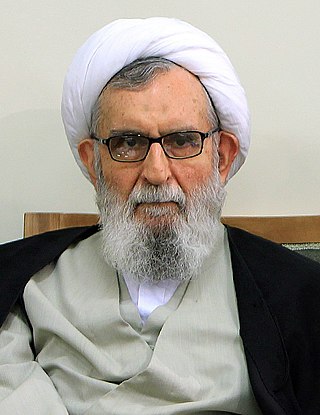Al-Quds is an Arabic name for Jerusalem.

The Sanctuary of Imām 'Alī, also known as the Mosque of 'Alī, located in Najaf, Iraq, is a mausoleum which Shia and Sunni Muslims believe contains the tomb of 'Alī ibn Abī Tālib, a cousin, son-in-law and companion of the Islamic prophet Muhammad. The Shī'as consider 'Alī as their first Imām and the first of the twelve caliphs of Muhammad, and the Sunnis regard him as the fourth Sunni Rashid Caliph. According to Shī'ite belief, buried next to 'Alī within this mosque are the remains of Adam and Nuh (Noah). Each year, millions of pilgrims visit the Shrine and pay tribute to Imām 'Alī.

Mashhad is the second-most-populous city in Iran, located in the relatively remote north-east of the country about 900 kilometres from Tehran. In the Central District of Mashhad County, it serves as the capital of Razavi Khorasan Province, the county, and the district. It has a population of about 3,400,000, which includes the areas of Mashhad Taman and Torqabeh.

Razavi Khorasan Province is one of the 31 provinces of Iran, located in northeastern Iran. Its capital is the city of Mashhad. Central Khorasan is one of the three provinces that were created after the division of Khorasan Province in 2004. In 2014, it was placed in Region 5 with Mashhad as the location of the region's secretariat.

The Central Library of Astan Quds Razavi is a large library in Mashad, Iran. Established before 1457, it holds over 1.1 million volumes. It is an international center for Islamic research, containing numerous manuscripts and rare works of antiquity of Islamic history.

The Shrine of Fatima Masumeh is located in Qom, which is considered by Twelver Shia Muslims to be the second most sacred city in Iran after Mashhad.

Abbas Vaez Tabasi was an influential Iranian cleric who held memberships at different institutions. He was Grand Imam and Chairman of the Astan Quds Razavi board from 1979 until his death in 2016.

Astan Quds Razavi is a bonyad based at Mashhad, Iran. It is the administrative organization which manages the Imam Reza shrine and various institutions which belong to the organization.

The Imam Reza shrine, located in Mashhad, Iran, is an Islamic shrine containing the remains of Ali al-Rida, the eighth Imam of Shia Islam. It is the largest mosque in the world by area. Also contained within the complex are the Goharshad Mosque, a museum, a library, four seminaries, a cemetery, the Razavi University of Islamic Sciences, and other buildings.

Shahr Khodro Football Club, previously known as Padideh, is an Iranian football club based in Mashhad, Razavi Khorasan, that competes in the Persian Gulf Pro League. The club was founded in 2013 and was known as Padideh Khorasan Football Club between 2013 and 2019, and between March and August 2021.

Grand Ayatollah Sayyed Abdullah Al-Musawi Al-Shirazi was a Grand Ayatollah of Twelver Shi'a Islam.

The Imam Reza Stadium is an all-seated football stadium located in Mashhad, Iran. The stadium has a seating capacity of 27,700 and is the sixth biggest stadium in Iran. It hosts some matches of the Iran national football team. The stadium completed in January 2017 and was opened on 14 March 2017 on the day of Chaharshanbe Suri.
Mehdi Azizian is an Iranian businessman and economist who was President and CEO of Astan Quds Razavi (AQR) from 1 March 2014 until 29 March 2016. He was previously Economic Vice President of the company.

Gholamreza Ghodsi was a belletrist and poet from Mashhad, Iran.
The following is a timeline of the history of the city of Mashhad, Iran.

Ayatollah Haj Mirza Khalil Kamarah'i. He was an author, researcher and philosopher of contemporary theology that sought to unite the Muslim sects supporting his cause. He studied under Abdul-Karim Ha'eri Yazdi in Arak and Qom. He continued his studies of various Islamic subjects and philosophy throughout his life. He worked with the administration in the Vatican City on various philosophical questions, which he later released in a separate book. He travelled to Cairo on behalf of Seyyed Hossein Borujerdi and Mahmud Shaltut, the Grand Mufti and dean of Al-Azhar University Sheikh, for fatwa. He was an imam for the Jamaat of Fakhr Al-dole mosque in Tehran for more than three decades and taught at the University of Theology in Tehran for five years.

Ahmad Marvi is an Iranian Twelver Shia cleric, former general and former police officer who was appointed as the custodian of Astan Quds Razavi by the supreme leader of Iran, Seyyed Ali Khamenei.

Soltan Mohammad Mirza better known by his honorific title Sayf ol-Dowleh was an Iranian prince of the Qajar dynasty and thirty-ninth son of Fath-Ali Shah, king of Qajar Iran. He was the governor of Isfahan between 1820 and 1835 and contributed to its restoration after the damage it suffered in the civil war between Zand sovereigns and Agha Mohammad Khan, rebuilding several of the Safavid pavilions and designing his own palace.
With the establishment of the Safavid dynasty, Shiism was declared the official religion of Iran. In implementing this purpose, the Safavid kings developed the holy places as a place for the Shia people by expanding the culture of endowment and creating endowments. The shrine of Imam Reza in Mashhad, the only tomb of Shia imams in Iran, was the most important religious shrine and the Safavids' focus. The Safavid kings tried to expand it in various ways, including allocating government budgets and endowments and giving ornaments and charity. One of the significant results of their performance was the increase in endowments of the Imam Reza shrine, which continued in the direction of creating a center for the spread of Shia culture, its prosperity, and continuity.
Sayyid Husayn Al Thabit, also known as Husayn Nayeb o-tolieh or Husayn Arab, was an Iraqi-Iranian nobleman, writer, statesman, and custodian of the Abbas shrine, as well as deputy custodian of the Imam Reza shrine.














